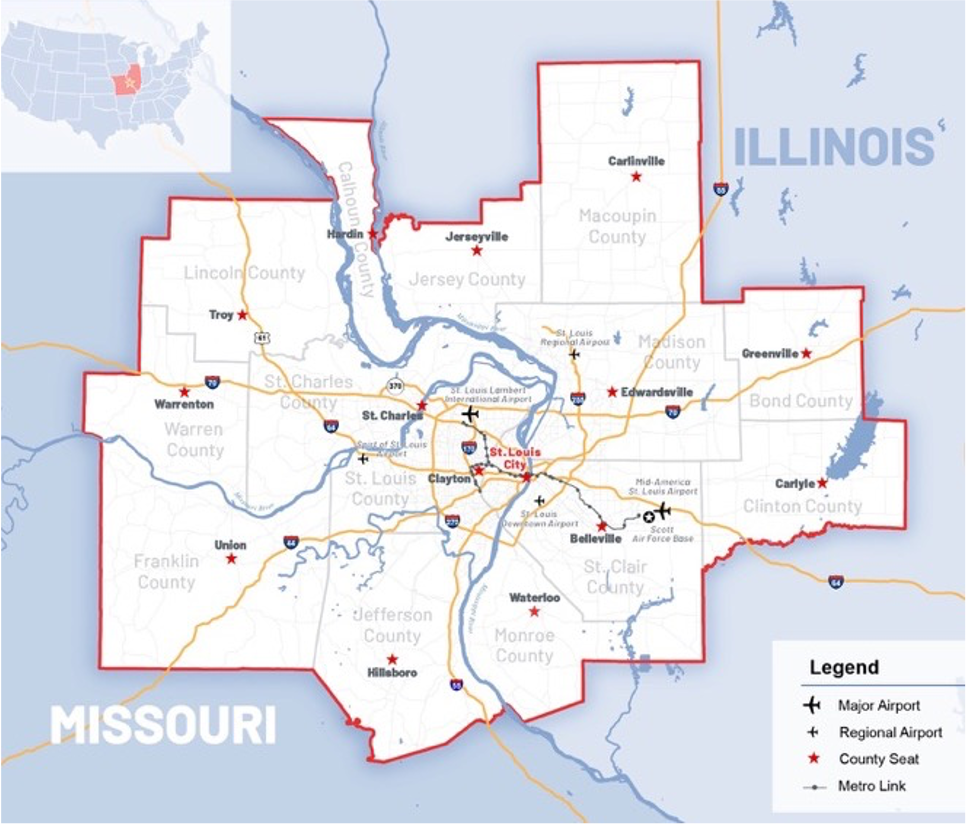Take a Closer Look at Our 15-County Region
Greater St. Louis perfectly balances convenience and affordability with the advantages of a broadly talented workforce, exceptional educational and cultural institutions, and superb recreational opportunities. This blend, along with our central location and extraordinary transportation assets, makes the region an ideal home for progressive companies competing in and connected to the global economy.
2.8
Metro Population
22
Established Here
88%
of the U.S. Average
By the Numbers
Greater St. Louis, the nation’s 23rd largest metro, is one of the largest regional economies in the U.S., with a gross metro product of $210 billion. The 15-county bi-state area comprises 2.8 million residents, 1.5 million workers and 88,000 business establishments. Throughout its history, St. Louis was founded as a trading center, grew into a manufacturing powerhouse, expanded its service sector, and developed into a major tech hub. The region ranks as the third most economically diverse U.S. metro area mirroring the national industry mix. Greater St. Louis has competitive strengths in advanced manufacturing, bioscience and health innovation, digital transformation, financial and business services, and mobility and transportation.
At the Center
The region is a major national transportation hub close to the geographic and population centers of the U.S. Located at the intersection of three major rivers, five interstate highways, five airports and six Class I railroads, our strategic central location provides efficient access to U.S. and global markets.

Cultivating Talent
Greater St. Louis has a vast and talented workforce of 1.5 million people. And each year, we welcome about 50,000 people relocating into the region, a major source of new workforce talent for employers. Workers are employed in a range of specialized occupations, including business specialists, technicians, scientists, engineers, healthcare professionals, teachers, artists, computer programmers, analysts, and more.
In Greater St. Louis, workers and employers both are supported by one of the largest educational markets in the U.S., producing considerable numbers of new graduates every year. Thirty four-year colleges and universities enroll more than 100,000 students and award more than 25,000 bachelor's or advanced degrees annually, while over 40,000 attend the St. Louis region’s 10, two-year community, vocational, and technical colleges. Here, more than 35 percent of adults have a bachelor’s degree or higher, well above the U.S. average.
Building Businesses
Greater St. Louis is home to 22 major headquarters listed on the Fortune 1000, Forbes Global 2000 and Forbes list of America’s Largest Private Companies. These companies have locations across the globe, employ hundreds of thousands of people and have hundreds of billions in revenues.
Currently, in the midst of an entrepreneurial renaissance, Greater St. Louis forms more than 6,000 new businesses annually — a number that employs more than 50,000. Venture capital investment in area startups has risen to record levels recently, with more than $400 million invested in 2020.
Greater St. Louis has a Cost of Doing Business index of 93 percent of the U.S. metro average, a key advantage for a large metro area. The region’s affordability and income levels offer the seventh-highest standard of living among the 53 largest U.S. metro areas.
Looking to Do Business in Our Region?
The work of our business attraction team is confidential, complimentary, and comprehensive. If you’re looking to consolidate, expand or move, we’re here to assist.

